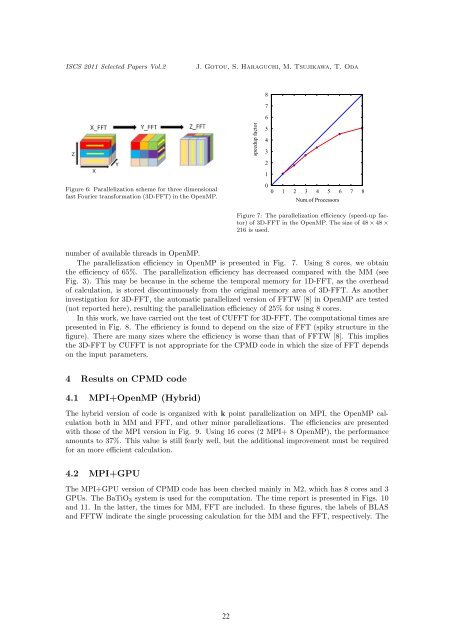RECENT DEVELOPMENT IN COMPUTATIONAL SCIENCE
RECENT DEVELOPMENT IN COMPUTATIONAL SCIENCE
RECENT DEVELOPMENT IN COMPUTATIONAL SCIENCE
Create successful ePaper yourself
Turn your PDF publications into a flip-book with our unique Google optimized e-Paper software.
ISCS 2011 Selected Papers Vol.2 J. Gotou, S. Haraguchi, M. Tsujikawa, T. Oda<br />
Figure 6: Parallelization scheme for three dimensional<br />
fast Fourier transformation (3D-FFT) in the OpenMP.<br />
speedup factor<br />
8<br />
7<br />
6<br />
5<br />
4<br />
3<br />
2<br />
1<br />
0<br />
0 1 2 3 4 5 6 7 8<br />
Num.of Processors<br />
Figure 7: The parallelization efficiency (speed-up factor)<br />
of 3D-FFT in the OpenMP. The size of 48 × 48 ×<br />
216 is used.<br />
number of available threads in OpenMP.<br />
The parallelization efficiency in OpenMP is presented in Fig. 7. Using 8 cores, we obtain<br />
the efficiency of 65%. The parallelization efficiency has decreased compared with the MM (see<br />
Fig. 3). This may be because in the scheme the temporal memory for 1D-FFT, as the overhead<br />
of calculation, is stored discontinuously from the original memory area of 3D-FFT. As another<br />
investigation for 3D-FFT, the automatic parallelized version of FFTW [8] in OpenMP are tested<br />
(not reported here), resulting the parallelization efficiency of 25% for using 8 cores.<br />
In this work, we have carried out the test of CUFFT for 3D-FFT. The computational times are<br />
presented in Fig. 8. The efficiency is found to depend on the size of FFT (spiky structure in the<br />
figure). There are many sizes where the efficiency is worse than that of FFTW [8]. This implies<br />
the 3D-FFT by CUFFT is not appropriate for the CPMD code in which the size of FFT depends<br />
on the input parameters.<br />
4 Results on CPMD code<br />
4.1 MPI+OpenMP (Hybrid)<br />
The hybrid version of code is organized with k point parallelization on MPI, the OpenMP calculation<br />
both in MM and FFT, and other minor parallelizations. The efficiencies are presented<br />
with those of the MPI version in Fig. 9. Using 16 cores (2 MPI+ 8 OpenMP), the performance<br />
amounts to 37%. This value is still fearly well, but the additional improvement must be required<br />
for an more efficient calculation.<br />
4.2 MPI+GPU<br />
The MPI+GPU version of CPMD code has been checked mainly in M2, which has 8 cores and 3<br />
GPUs. The BaTiO3 system is used for the computation. The time report is presented in Figs. 10<br />
and 11. In the latter, the times for MM, FFT are included. In these figures, the labels of BLAS<br />
and FFTW indicate the single processing calculation for the MM and the FFT, respectively. The<br />
22


